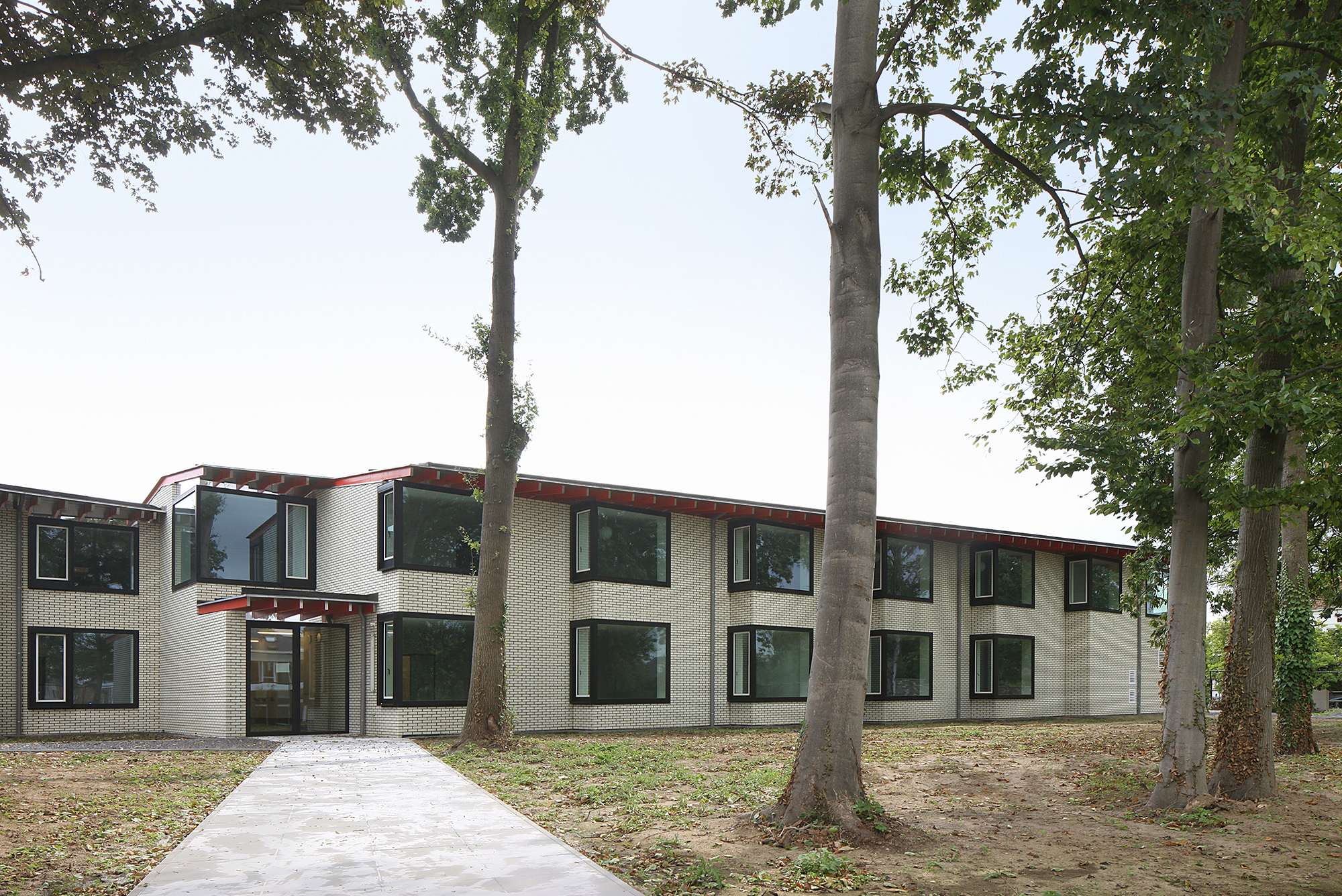98 Individual Addresses: Seniors’ Living Complex in Ternat

The Kapelleveld seniors’ living and care centre stands in the middle of the small Belgian city of Ternat, and yet in the green as well, which is nothing unusual for a community of 15,000. How to add a new building complex with 98 apartment units here, amid single-family dwellings and supermarkets? The architects have distributed the spatial program over six wings of different lengths; these are connected via a central crosspiece. This is home to the communal areas, above all a large cafeteria with an open-air terrace, plus a hair salon, consulting rooms and administration offices. The six living wings are accessed via double-loaded central corridors. The four shorter hallways accommodate the 57 care rooms, while the two longer ones have 41 barrier-free apartments for independent living.
In order to prevent any hint of monotony in the access corridors and the façades, the living units and rooms are arranged diagonally to each other. Along the hallway, narrower and wider sections alternate. Each of the wider sections features two entrances set diagonally opposite each other. On the exterior of the building, this play is repeated in a series of corner windows on both storeys. In the care rooms, the narrow side of this glass corner can be opened, while the longer side has fixed glazing. In the apartments, doors lead from these bays to jutting balconies and terraces.
The many-limbed building is held together by a shared roof which has a shallow slope and dramatic jut. In the choice of materials and detailing, the architects have remained true to their principle of separating themselves from regional building traditions by means of unconventional colour combinations and exaggerated forms. However, when it comes to scale, they have only gone so far as allowed by a sense of respect for the local context. In Ternat, brick buildings are ubiquitous, but not often seen in the cream shade that de vylder vinck taillieu have chosen for their design. In order to lend an autonomous plasticity to the glass bays set into the masonry work, they have been adorned with extra-wide, black frames and are shaded by aqua-coloured awnings. Under the slender eaves, tightly packed, red-painted cantilever arms jut forth; their front sides have been clad with stainless-steel plates to prevent water damage and rot.
In order to prevent any hint of monotony in the access corridors and the façades, the living units and rooms are arranged diagonally to each other. Along the hallway, narrower and wider sections alternate. Each of the wider sections features two entrances set diagonally opposite each other. On the exterior of the building, this play is repeated in a series of corner windows on both storeys. In the care rooms, the narrow side of this glass corner can be opened, while the longer side has fixed glazing. In the apartments, doors lead from these bays to jutting balconies and terraces.
The many-limbed building is held together by a shared roof which has a shallow slope and dramatic jut. In the choice of materials and detailing, the architects have remained true to their principle of separating themselves from regional building traditions by means of unconventional colour combinations and exaggerated forms. However, when it comes to scale, they have only gone so far as allowed by a sense of respect for the local context. In Ternat, brick buildings are ubiquitous, but not often seen in the cream shade that de vylder vinck taillieu have chosen for their design. In order to lend an autonomous plasticity to the glass bays set into the masonry work, they have been adorned with extra-wide, black frames and are shaded by aqua-coloured awnings. Under the slender eaves, tightly packed, red-painted cantilever arms jut forth; their front sides have been clad with stainless-steel plates to prevent water damage and rot.
Further information:
Planning of structural framework: Pascal de Munck
TGA-planning: Studiebureel Boucherie/Maes Projects
Contractor: Jan De Nul
Planning of structural framework: Pascal de Munck
TGA-planning: Studiebureel Boucherie/Maes Projects
Contractor: Jan De Nul

